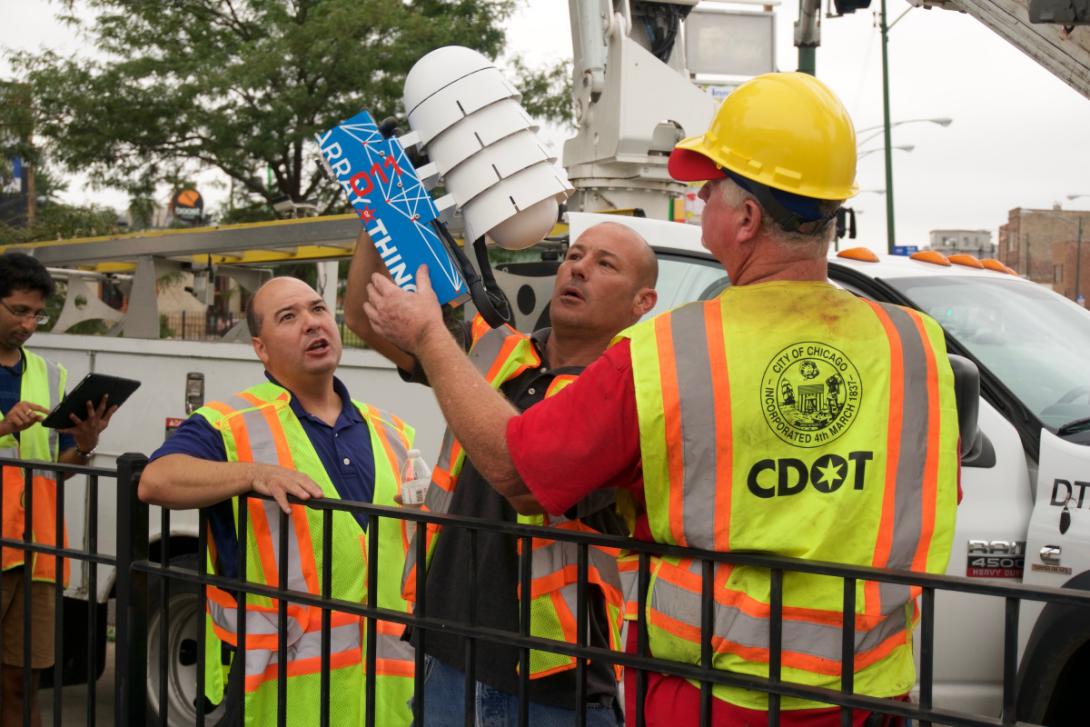A Smart Solution to Crumbling Infrastructure
The U.S. infrastructure increasingly shows signs of aging, posing a threat to essential services. These conditions put the United States at a crossroads. Governments at all levels, working with the private sector, can either design the infrastructure of the future—one that will intelligently support community services and resident needs for decades to come—or continue to apply just-in-time repairs to the strained system.
Critical infrastructure forms the backbone of cities and communities. It comprises the roads, pipes and wires that provide the transportation, water and power systems essential to lives and livelihoods. Ultimately, rebuilding critical infrastructure goes beyond fortifying steel and patching potholes. It is about rethinking the infrastructure from the ground up.
One way to build a backbone that integrates 21st-century technologies—sensors, ultra-high-speed communication networks, data analytics, and control and automation—is to enable infrastructure to be much more responsive to real-time demands and more resilient during and after disasters. The opportunities and capabilities to make these systems more intelligent exist today and could catalyze productivity and prosperity for many years.
In some places, the introduction of technology into the nation’s cities and communities is already happening, giving rise to intelligent infrastructure and enabling the smart and connected communities of the future. For example, Chattanooga, Tennessee, is sometimes called “Gig City” because of its investments in high-speed Internet connectivity as a path to economic development. Starting in 2009, the Electric Power Board of Chattanooga, an electricity distribution and telecommunications company the city owns, transformed its electric grid by installing a high-speed fiber network and automated switches. The smart grid was designed to prevent power outages and to return service to customers quickly after disruptions.
The approach worked. In July 2012, when the southeastern region of Tennessee experienced a destructive and deadly fast-moving windstorm known as a derecho, the technology prevented an estimated 50,000 homes from losing power—at least half of the would-be outages. The new grid also shortened the duration of the outages by an estimated 36 hours for those affected, and it resulted in $1.4 million in direct operational savings in response to that storm. Annual savings in overall operational costs are estimated at $1.6 million.
These reductions were made possible by integrating an underlying high-speed communication network with the energy grid. To translate Chattanooga’s success to communities across the United States, innovations in advanced networks and the intelligent infrastructure that will rely upon such capabilities must be encouraged and supported.
The National Science Foundation (NSF), an independent federal agency that supports fundamental research and education across all fields of science and engineering, is attempting to do just that. Since 2012, the NSF has supported innovations in ultra-high-speed communication networks and the applications and services that leverage these networks to benefit the public in areas such as energy, transportation, health care, public safety and disaster response.
Last year, the NSF supported research that integrates fast, responsive communication networks with critical infrastructure. The capability would enable the real-time data transmission needed for well-connected, intelligent systems and scale findings throughout an entire community as well as across multiple communities.
Recently, the NSF announced 38 awards totaling almost $19.5 million through a new program called Smart and Connected Communities (S&CC). These awards address a range of application domains, including public safety and disaster response, water systems, community health and wellness, energy, transportation, manufacturing, food systems and urban planning.
One of the S&CC projects will conduct research in four communities across the United States to enable next-generation stormwater systems. The project will use sensors, data and high-speed networking to anticipate weather changes and adapt stormwater management in real time. This effort, led by Branko Kerkez at the University of Michigan, will drastically enhance community resilience after floods and other natural disasters.
Furthermore, the NSF and a consortium of more than 30 companies and technology associations in the wireless sector have initiated an investment of $100 million over seven years for the design, development, deployment and initial operation of advanced wireless research platforms through the NSF’s Platforms for Advanced Wireless Research (PAWR) Project Office. The investment includes $50 million in cash and in-kind contributions from the consortium.
As a result of this public-private partnership, city and community leaders, industry partners and researchers will use these platforms to innovate and scale new networking capabilities. The platforms will combine with critical infrastructure to intelligently support community and resident needs. Solutions could include vehicle-to-vehicle and vehicle-to-infrastructure communications as well as real-time disaster response.
In pursuing these possibilities, the NSF is specifically striving to foster deep collaborations that are broader than the foundation’s core constituency of academic researchers. These partnerships actively engage community residents, entrepreneurs, industry partners, civic leaders and policy makers in ways that will enable the integration and acceleration of efforts to revitalize critical infrastructure and services.
As U.S. cities and communities continue to experience growth and development, they must address their aging and deteriorating critical infrastructure. Modern technology can transform infrastructure to be more flexible and capable of responding to change and to generate innovation and economic growth as well as a competitive advantage. But this transformation that can define the future requires sustainable cross-sector partnerships rooted in the cities and the communities they serve and fundamental research in networking and intelligent infrastructure.
Erwin Gianchandani, Ph.D., is the National Science Foundation’s (NSF’s) deputy assistant director for Computer and Information Science and Engineering (CISE). Meghan Houghton, Ph.D., is staff associate for strategic engagements at the NSF’s CISE and has helped lead the foundation’s Smart and Connected Communities program.






Comments